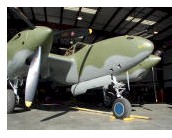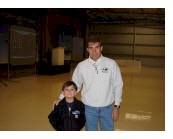
Harley Earl was head of General Motors' Art and Color Department in the 20s,
30s and 40s. In 1939 he was permitted a sneak peek at the P‑38
Lockheed Lightning at the then top-secret Selfridge Field in Detroit. Earl
thought it was a strikingly beautiful aircraft, and he set about creating a new
Cadillac that would take its styling cues from the P‑38.
He was so impressed with the P‑38 design that he borrowed
heavily from it to create an innovative model for their new Cadillac. The
models featured bulbous, bullet-like noses, pontoon front fenders, the
warplane's enormous wraparound windscreen...and, of course, those now-famous
"tail fins" -- which were directly influenced by the unusual twin booms of the P‑38 and their dominant fins. These tailfins became the signature
for Cadillac and set GM styling trends for many years to come. While there were
structural reasons for the design of the fins on the P‑38, the fins
on the Cadillac were strictly for "style" and were intended to suggest speed and
flight in the car. The '48 Cadillac was the spirit of the "P‑38
Lightning" -- on the ground instead of in the air.
...and the 1950 Studebaker!
 The Lockheed P‑38 was inspiration for Raymond Loewy and his design team at The Lockheed P‑38 was inspiration for Raymond Loewy and his design team at
Studebaker for the 1950 and 1951 model years.
...and the 1953 Hudson Hornet!
Flying Hudsons
Over the years I have been fortunate to be able to work with members of the
Planes of Fame Museum in Chino, California. This museum has one of the most
unique and well-maintained collections of World War II fighting airplanes in
the country. Unlike many other WWII war-bird collections, these are not
just static displays, since most of the aircraft are flown on a regular
basis!
After much digging, I found a direct tie-in between Hudson Motor Car Company
and these revered relics of a past age.
In 1940-1941 Hudson, like all the auto manufacturers of the day, knew that
the country was on the brink of war. On December 7th, 1941, the
destiny of the United States and Hudson would be linked forever since Hudson
began manufacturing a number of different products for military
applications. The innovative manufacturing independent produced Oerlikeon
anti -aircraft guns, aircraft fuselages, the incredible “Invader” landing
craft engine and the wings of the famous Lockheed P‑38 Lightning. The
wingspan of the P‑38 was 52 ft. Mounted on those wings were two Allison
liquid‑cooled V‑12 engines. The wings were built on an assembly line at the
main plant located on Jefferson Avenue, and then shipped to Burbank, CA for
final assembly at Lockheed.
The P‑38 Lighting served our pilots well in both theatres of operation, and
was credited for shooting down Japanese Admiral Isoroku Yamamoto, the
mastermind behind the attack on Pearl Harbor. The top two American aces of
all time, Maj. Richard Bong (40 confirmed victories) and Maj. Thomas McGuire
(38), both flew the Hudson-winged P‑38 Lightnings in the South Pacific.

Because of Hudson’s involvement in the making of the P‑38, I have taken a
special interest in the aircraft and its accomplishments. The museum was
hosting a famous visiting P‑38 by the name of “Glacier Girl’. The History
Channel did an in-depth documentary on the recovery and restoration of this
piece of Hudson history. On July 15, 1942, lost in bad weather, a flight of
six P‑38’s were forced to land on the Greenland Icecap. The crewmen were
rescued and the warplanes abandoned. During the summer of 1992 one of
the P‑38’s, which was buried under 268 feet of ice and snow, was finally
recovered. On October 2002, after 10 years of restoration, the P‑38
now known as “Glacier Girl” took her first flight. (See
story here.)
 I spoke with Bob Cardin
(pictured at left with Quentin Roberts, Jr.), the man responsible for the restoration of the
aircraft, and he was not even aware of the fact that Hudson had manufactured
the wings! I asked him if he had seen any markings or stampings from
manufacturers on the recovered plane. He said the outer skin of the plane
had been damaged severely by the weight of the ice, so it was difficult to
tell what was what when piecing it together. I spoke with Bob Cardin
(pictured at left with Quentin Roberts, Jr.), the man responsible for the restoration of the
aircraft, and he was not even aware of the fact that Hudson had manufactured
the wings! I asked him if he had seen any markings or stampings from
manufacturers on the recovered plane. He said the outer skin of the plane
had been damaged severely by the weight of the ice, so it was difficult to
tell what was what when piecing it together.
The Planes of Fame Museum is fortunate to have a beautiful P‑38 (23 Skidoo)
as a permanent member of its collection. When the Glacier Girl and 23 Skidoo flew together that day in October, it was the first time that two
P‑38s were in the air together since the end of World War II.
It was, for all of us, a truly memorable sight!
Quentin Roberts
|


